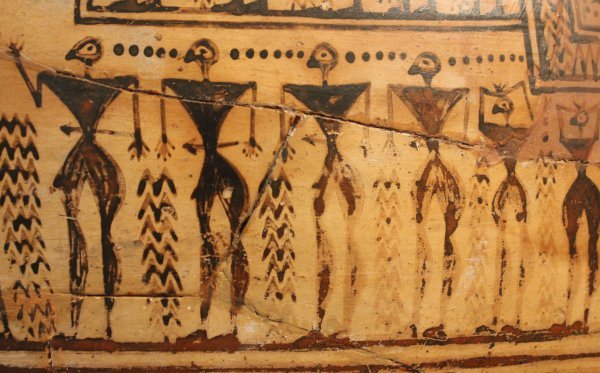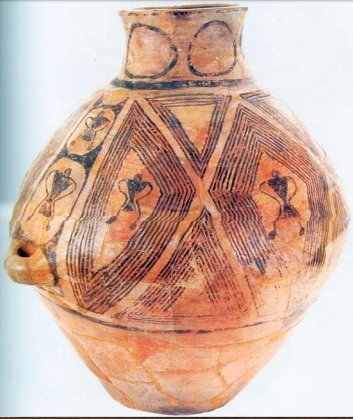Iurii Mosenkis
The Cucuteni-Trypillia culture, Orion constellation,
and 4000-year prehistory of Greek geometric art
Heavenly inspired painting of the Cucuteni-Trypillia culture and, later, Greek geometric art might include bi-triangle figure of Orion constellation
Key words: Cucuteni-Trypillia culture (Trypillian culture), geometric art (geometric period) of Ancient Greece, archaeoastronomy, Orion constellation
Юрій Мосенкіс
Культура Кукутень-Трипілля, сузір’я Оріона
та 4000-літня передісторія грецького геометричного мистецтва
У Трипільській культурі, серед інших зображень, добре відомі людські фігури, що складаються з двох поєднаних трикутників. Форма такої фігури відповідає формі сузір’я Оріона. У день весняного рівнодення (найважливіший день року – його початок у більшості календарних традицій світу) Сонце було розташоване біля цього великого й добре помітного сузір’я саме в ті часи, коли трипільці зображували ці фігури на посуді.
У часи розквіту давногрецького геометричного мистецтва (початок І тисячоліття до н.е.) сузір’я Оріона знову було пов’язане з однією з кардинальних точок сонячного року. Наяскравіша зірка цього сузір’я сходила перед сходом сонця в день літнього сонцестояння.
Отже, подібні астрономічні образи, спостережувані на сакральному небі, викликали схожі мистецькі образи трипільської культури і давньогрецького геометричного мистецтва.
Автор щиро вдячний Н.Б. Бурдо і М.Ю. Відейку за цінні консультації.
Ключові слова: культура Кукутень-Трипілля (трипільська культура), геометричне мистецтво (геометричний період) Стародавньої Греції, археоастрономія, сузір’я Оріона

The Greek Dipylon Amphora, mid-8th century BC. The picture after: [Геометрический стиль]

Greek-like ‘geometric art’ of the Cucuteni-Trypillia culture,
Ukraine and Moldova, 3700–2700 BC [Бикбаев, с. 242]. N. B. Burdo kindly drew my attention
to the picture and Cucuteni-Trypillian geometric art in general. See also: [Бурдо 2005, с. 165]

Cucuteni vessel, Romania, about 4000 BC [Бурдо 2005, с. 246]
Well-known symbol of Greek geometric art is the bi-triangle human figure depicted on vessels. It appeared in Cucuteni-Trypillia about 4000 BC (Cucuteni AB3, B1 (4200–4100 BC), Trypillia BII (4100–3900 BC); information and dates are proposed by M. Yu. Videiko) and frequently used in 3400–3200 BC. Similar bi-triangle clay statuettes (without known prototypes in plastic art) are known in the Baden culture during 3200–3000 BC. See drawing: [Horváth 2008, p. 87][1].
The constellation of Orion has similar bi-triangle form. 4000–3000 BC was a time when the brightest star of the constellation rose before the sunrise in the summer solstice. The sun was located near the star in the spring equinox whereas the full moon – in the autumn equinox. Thus Orion and its brightest star marked cardinal points of the sun during a year.
The similar astronomical picture might be observed in Geometric Greece, 900–700 BC: the brightest star of Orion rose before the sunrise in the summer solstice.
Thus, Trypillians during 4000–3000 BC and Greeks during 900–700 BC observed the similar celestial picture: giant figure of Orion rose before the sunrise in the summer solstice.
The author was kindly consulted by N. B. Burdo and M. Yu. Videiko.
Bibliography
Бикбаев В. М. Расписная амфора со сценами ритуальных танцев.., Interactions, changes, and meanings, S. Ţerna, B. Govedarica (eds.), Kishinev 2016.
Бурдо Н. Б. Сакральний світ трипільської цивілізації. – К., 2005 (electronic edition).
Геометрический стиль, available at: https://ru.wikipedia.org/wiki/Геометрический_стиль
Horváth, T. Balatonőzöd – an unusual Baden settlement? The Baden Complex and the outside world, Bonn [2008].
